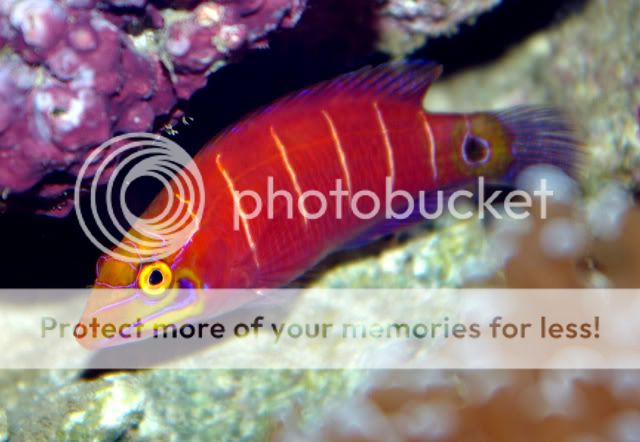Well, I'll describe the fish by Genus as their behavior and care are pretty much governed that way.
Cirrhilabrus
Cirrhilabrus wrasses are by far and away some of the most beautiful fish that we keep in our aquariums. Their care is pretty simple. They're usually VERY omnivorous and will eat almost any aquarium food offered. They will often voraciously hunt pods and flatworms in the aquarium. Unfortunately when they get larger and older, they CAN predate on small shrimps like peppermints and/or cleaner shrimp. When younger, around 2" they're fine with shrimps, but when they start getting bigger around 4" this becomes a problem. As for tank size, generally an aquarium at least 3' long should be had to keep these wrasses through adult hood. They are very active swimmers in the aquarium and easily spooked into jumping, so a hood and/or eggcrate covering is a MUST for these fish. It's not if they will jump, but WHEN. One final word of caution when choosing a Cirrhilabrus wrasse, they are sometimes not the best shippers, and prone to disease when first introduced to the aquarium. ALWAYS quarantine them before adding to your tank.
Paracheilinus and Pseudocheilinus
These wrasses are very similar to their Cirrhilabrus cousins from a care standpoint. Omnivorous, active swimmers, jumpers. They are not however prone to attacking shrimp as they are generally a much smaller fish. Furthermore, they are also more timid than other wrasses and should likely be added first in the aquarium. The exception would be Pseudocheilinus which CAN become aggressive when older.
Macropharyngodon
One of the msot difficult fish to keep in the aquarium trade period. Macropharyngodon, aka leopard wrasses are some of the toughest fish to get to live and thrive. Their main problems are that they have VERY small mouths and are VERY difficult to get to take frozen food. Very similar to mandarins in this regard. Furthermore they are exceptionally timid fish which can be easily discouraged from feeding by other fish in the aquarium. If you wish to keep a Macropharyngodon wrasse, it will have to be added early into the aquarium BEFORE it becomes crowded, choose a very large one, and feed lots of frozen as they rarely take well to flake/pellet food. Once established in captivity, they can live for MANY years there, but getting them established is extremely hard.









 )
)








 /www.facebook.com/LiveAquaria#/album...;id=32999209705
/www.facebook.com/LiveAquaria#/album...;id=32999209705
 /www.facebook.com/LiveAquaria#/album...;id=32999209705
/www.facebook.com/LiveAquaria#/album...;id=32999209705Why do I always like the hard to keep fish




